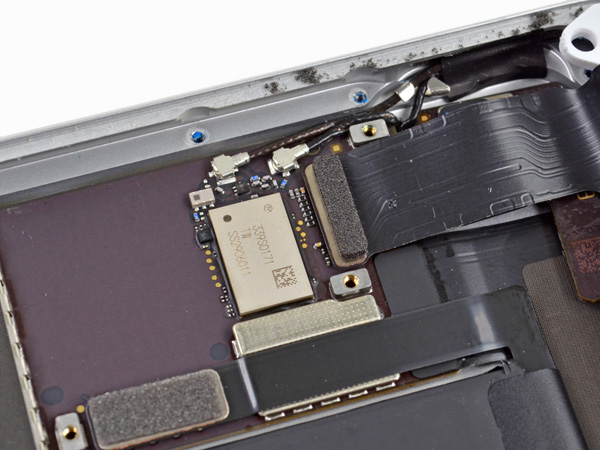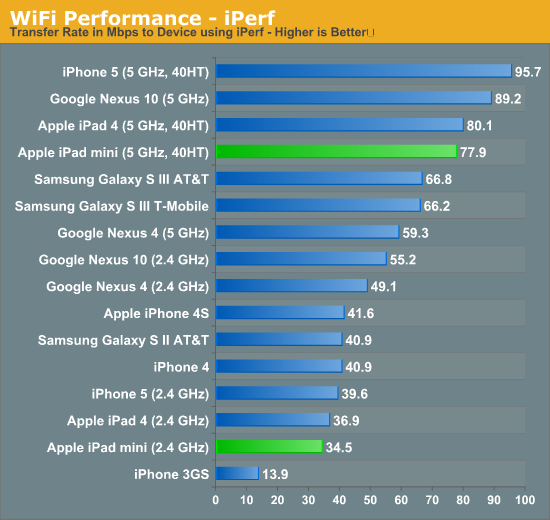iPad mini Review
by Anand Lal Shimpi & Vivek Gowri on November 20, 2012 6:10 PM ESTWiFi Performance
The mini uses the same Broadcom BCM4334 WiFi controller as the iPhone 5. The WiFi stack supports dual-band 802.11n as well as fallback to 802.11b/g.

iPad mini WiFi controller - image courtesy iFixit
Since the mini uses the same WiFi stack as the iPhone 5, you get support for 40MHz channels on 5GHz networks (20MHz on 2.4GHz). The maximum PHY rate supported is 72Mbps on 2.4GHz and a whopping 150Mbps on 5GHz.

In terms of actual performance, this works out to be a maximum of just under 100Mbps on a 5GHz network with 40MHz channels. In practice I wasn't able to get higher than 91Mbps, although Brian managed a very nice 95.7Mbps on the iPhone 5 in his tests. On average I pulled nearly 78Mbps on the mini on a 5GHz network. Move down to 2.4GHz and performance is cut roughly in half (peak performance is around 41Mbps).

I didn't have any issues with WiFi reception or performance in my testing of the iPad mini. The only complaint I really have at this point is I would love to see more intelligence when it comes to switching between multiple known APs of varying signal strengths. This is a problem on pretty much all devices I play with, they tend to want to stay on an existing network even if its performance drops significantly and there is another, better performing network that could be jumped to. I feel like some more intelligence in this department (testing nearby networks, looking for an ability to seamlessly switch and get better performance) would help mitigate a lot of the inevitable "hey my WiFi is broken" complaints we often see with a move to a new WiFi stack. You could also argue that we just need better designed WiFi deployments.










140 Comments
View All Comments
Calista - Wednesday, November 21, 2012 - link
^+1I bought the original iPad and as many was amazed by the build-quality (stupid sharp edges excluded) and how fluid surfing the web felt considering the hardware. But I also within 15 minutes realised that it was badly memory-starved. Apple is an amazing company taking great pride in the user-experience of its products, but back then they goofed up badly.
I feel the same about the Mini. The CPU may be old but it's still fairly competent, the GPU still among the best, and the screen size may be close to perfect. But only 512 MB of RAM just ain't sufficient for today, even less for tomorrow.
ltcommanderdata - Wednesday, November 21, 2012 - link
Being slow to increase RAM and VRAM is consistently an issue with Apple. That's the case with Macs as well.For the iPad 1, it wasn't just that 256MB of RAM was small. Rapid drop-off in app support for the iPad 1, especially in games, is due to the resolution being so high in comparison to the RAM. The GPU was also underpowered compared to the resolution. 3rd gen devices have 480x320 screens and 256MB of RAM while the iPad 1 has 5.1x the pixels with the same 256MB of RAM. The 4th gen iPod Touch is affected by this too having a 960x640 screen with 256MB, but the iPad 1 is even worse with 1.3x the pixels of the 4th gen Touch. Support for the 4th gen iPod Touch in games isn't perfect, but is better than the iPad 1, which indicates that 256MB in itself isn't the limitation, but the drop in support for the iPad 1 is a combination of 256MB RAM with the higher 1024x768 resolution and the iPad 1 no longer being sold after 2011. The iPad 1 received 2 major OS updates (iOS 4.x and 5.x) post launch like other iOS devices so its OS support wasn't prematurely terminated.
I think the situation will be different for the iPad Mini 1. The iPad 2/Mini doubles the RAM to 512MB while keeping the resolution the same, which alleviates the poor resolution-RAM ratio of the iPad 1. 512MB of RAM represents the majority of iOS devices including the iPhone 4, iPhone 4S, iPad 2, iPad Mini 1, and 5th gen iPod Touch, of which given historical patterns, the iPhone 4S and 5th gen iPod Touch and perhaps even the iPad Mini 1 itself will sell into 2014. Given historical patterns, OS support for the iPhone 4S, 5th gen iPod Touch, and iPad Mini 1 should continue into 2015. Seeing it's only in 2012 that developers are really beginning to require 512MB of RAM, I don't see them already upping the minimum requirement to 1GB in 2013. Especially not when that eliminates the majority of their potential customer base, when those devices are still being actively sold into 2014, and receiving OS support into 2015. I think 2014 is a more realistic date for when apps will begin to stop supporting 512MB devices.
Personally, seeing the CPU was unchanged and the GPU is only 2x faster despite the 4x increase in resolution making it slower at native resolution than the iPad Mini 1 and iPad 2, I wouldn't be surprised if the iPad 3 loses app support before the iPad Mini and iPad 2.
Of course, just because apps continue to support 512MB devices doesn't mean the usage experience won't be degraded or sub-par. I can see that becoming an issue faster than app support.
Klug4Pres - Wednesday, November 21, 2012 - link
I guess you reviews the Wifi-only version, but I'd like to see some analysis of the cellular connectivity options, especially what LTE bands are supported in the available SKUs.HighTech4US - Wednesday, November 21, 2012 - link
The mini lacks a GPS on the base model making it useless for using any map software with turn-by-turn prompts.The Nexus 7 has a built in GPS chip (and a very effective one and way better pin pointing location than a TomTom) and Google Maps works great on the Nexus 7 (you can download maps for offline use).
The lack of GPS on any tablet is a deal breaker for me.
Adding in the omission GPS with the other short comings along with its sky high price makes the mini just an overpriced iToy. The Nexus 7 is a much much better deal.
Calista - Wednesday, November 21, 2012 - link
I think we have all forgot what gave us forgot what gave us 7" tablets. A "tablet" - i.e a tablet PC running Windows was normally in the 12-14" range. The JooJoo was a 12" tablet as well. Apple brought it down to 10" and sold a ton of those.At the same time a large number of more or less obscure manufacturers brought out 7" tablets *not* because 7" was considered the best compromise but because those panels could be bought dirt-cheap. But this also gave us this idea that a small tablet was supposed to be 7" while a large tablet was to be 10". I would say this is an anomaly, tablets have for the last ten years been larger than 10".
Maybe the "correct" size for a small tablet is in the 8-8.5" range? I was playing with my friends Motorola Xoom 2 (8.2", 1280x800) and while a bit heavier than my 7" tablet it seemed to hit the perfect size. Not so big or heavy as to be cumbersome, while still packing almost 40" more screen area.
Too much focus is being put on the device being pocket-able, how many really bring a tablet in their coat or pants? Just the idea of asking for a device to be pocket-able while still lacking a 3G/4G connection is just plain silly. Instead focus should be put on how it feels in hand but also how much space it occupies on a table. The 10" iPad was always too big to fit comfortable on my table while still having space for a cup of tea, a notebook, a plain book or the remotes for the TV and receiver.
Quad5Ny - Wednesday, November 21, 2012 - link
There is a Pop-over interactive banner ad running that opens when you try to hit the x, please take a look. Thanks.http://forums.anandtech.com/showthread.php?p=34271...
vicbdn - Wednesday, November 21, 2012 - link
"but in terms of repsonsiveness" In the conclusion.BSMonitor - Wednesday, November 21, 2012 - link
Incredibly too much... By the 4th generation of these, 32GB should be standard and 64GB a $100 upgrade...The BOM on 32GB NAND in this fashion is what? $15? Even if it's $20($10 x 2 16GB), they are getting a 1000% profit margin on that upgrade from 16 to 32 GB??
But they know we all have huge iTunes libraries we'd want on it...
Unfortunately there will never be a do-it-yourself tablet similar to the PC market. I stopped paying Dell and Gateway and HP a LONG time ago for their ridiculous profit methods.
TouchPadKing - Wednesday, November 21, 2012 - link
Not sure if this has already been rehashed, but the pixel size is what kills the ipad mini for me. I have a Samsung Galaxy Tab 7.0 Plus, and I can SEE the pixels and it drives me nuts. The ipad mini has an even bigger screen with about the same number of pixels... Also, samsung fits in pocket, mini doesn't. I like the ipad mini's form factor, but again if it won't fit in my pocket it'll probably never leave the house...Rising - Wednesday, November 21, 2012 - link
I bought Nexus 7 when it was released. This is what i can tell you after few months of usage.."Its a good hardware in a crappy software". Iwould say the higher price premium on ipad mini is justified for software.
Most of the apps are zoomed over apps for Nexus 7. I hate that part of it. For example i use this app called apex launcher in my samsung s 3 and when i try using it on Nexus 7 all the icons are so small that they are hardly recognizable.
I donot understand why Google cannot optimize the apps to their own Nexus tablets.
Anand do you know whats stopping them from doing this?